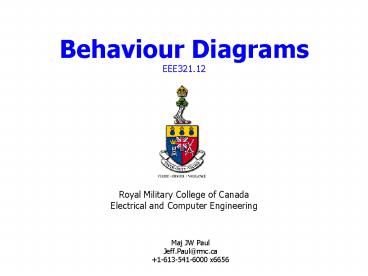Behaviour Diagrams EEE321.12 PowerPoint PPT Presentation
1 / 29
Title: Behaviour Diagrams EEE321.12
1
Behaviour Diagrams EEE321.12
Royal Military College of Canada Electrical and
Computer Engineering
- Maj JW Paul
- Jeff.Paul_at_rmc.ca
- 1-613-541-6000 x6656
2
Quod malum posset futurem
3
Lab 4
4
Polymorphism
parametric
An abstraction operates uniformly across
different types
run-time
universal
sub-type inclusion
An abstraction operates through an inclusion
relation
polymorphism
overloading
A single identifier denotes several abstractions
ad-hoc
compile-time
coercion
A single abstraction serves several types through
implicit type conversion
5
Sub Type Inclusion
- Things needed for a polymorphic function call
- Base Class Object Reference
- Over ridden methods
- Run-time Binding Mechanism
- (late dispatching)
- ALL THREE MUST BE PRESENT
6
Example?
public abstract class GameCharacter public
void whoAmI() public class Warrior
extends GameCharacter public void whoAmI()
mightyThor new Warrior(20,20,hammer)
mightyThor.whoAmI()
7
From Game.java (package gamedriver)
Warrior addToGame(Warrior newWarrior) if
(numWarriors maxWarriors) return null
numWarriors int i 0 while
(warriorsi ! null) i warriorsi
newWarrior return newWarrior
for each type of game character
what does this call?
GameCharacter addToGame(GameCharacter
newCharacter) if (numCharacters
maxCharacters return null numCharacters
int i 0 while (listOfCharactersi !
null) i listOfCharactersi
newCharacter return newCharacter
8
Todays Class
- Behaviour Diagrams
9
Analysis/Design Method
- Notation
- The language for expressing each model
- Process
- The activities leading to the orderly
construction of the systems models - Tools
- The artifacts that eliminate the tedium of
modeling building and enforcing rules about the
models themselves, so that errors and
inconsistencies can be exposed
10
Relationships
11
OO Relationships (Booch p 137)
- Dependency
- A change in the specification of one thing may
affect another thing that uses it, but not
necessarily the reverse - Generalization
- KIND of
- Association
- A structural relation, specifying that objects of
one thing are connected to objects of another
12
Recall UML
- Class Diagram
- Object Diagram
- Component Diagram
- Deployment Diagram
- Use Case Diagram
- Sequence Diagram
- Collaboration Diagram
- Statechart Diagram
- Activity Diagram
Structure diagrams
STATIC VIEW
Behaviour diagrams
DYNAMIC VIEW
13
Collaboration
- An application is the sum of its parts working
together. Each part (object, interface, etc)
plays a specific role - A society of classes, interfaces and other
elements that work together to provide some
cooperative behaviour thats bigger than the sum
of all its parts (Booch p 327)
14
Two parts to collaboration
- Structural Part
- Specifies the classes, interfaces, etc that work
together to carry out the required collaboration - Behavioral Part
- Specifies the dynamics of how these parts
interact - may request a value (getter or return value)
- may change the state of another object (setter)
Class Diagrams Object Diagrams
Collaboration Diagrams Sequence Diagrams Use-Case
Diagrams
15
Collaboration Diagram
- Looks a lot like an object diagram (still need
structure) - Usually use anonymous instances of classes
- May represents other items (other collaborations,
nodes, components, etc) - But we need a behaviour diagram
- Add messages
- method calls
- order of operation
16
Message calls
royalBank
Bank
getBalance(String, Double)
anATM
17
Recall Association vs Link see Booch p 209
1
employer
employee
assign(development)
Company
pPerson
In general, a link implies an association
18
Another Example
19
One more example
20
Object Visibility
21
Object Visibility
- It is often not apparent when first studied that
the design of object visibility is complex and
fundamental - The design of the web of object visibility's is
critical to a project solution - It is this web of visibility that provides the
vehicle for the object communication which
provides the solution to the problem
22
Object Visibility
- Associated with the understanding of object
visibility for a system, is object creation - Initially only an objects creator has
visibility, any other object which needs access
to this newly created object must get the
visibility from the creator either directly or
indirectly - visibility can flow through object references or
environment scope rules
23
Object Visibility
- The supplier object provides services through its
interface - The client object uses services of the supplier
- this means the client initiates a message to the
supplier - this means the client must have visibility to the
supplier - the supplier need not have visibility to the
client
24
Four Kinds of Visibility
- Global
- The supplier object is in a global scope to the
client - Field
- The supplier object is a part of the client
- Parametric
- The supplier object is a parameter to some
operation of the client - The client gains visibility of the supplier
through some exchange message with another object - Local
- The supplier object is a locally declared object
in the scope of the object diagram
25
Visibility Notation
26
Message Synchronization
27
Message Synchronization
- Messages may be passed
- From one passive object to another
- Assuming one flow of control
simple invocation of an
operation - From one active object to another
- asynchronously
- synchronously
- From an active object to a passive object
- What if multiple active objects call the passive
object - From a passive object to an active object
- ???
28
Need more modelling symbols
29
Review
- What is the purpose of a collaboration diagram?

